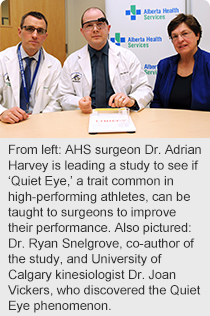
March 26, 2014
CALGARY – Researchers with Alberta Health Services (AHS) and the University of Calgary are studying a concept from the world of sports in the hopes it will one day improve surgical training.
The phenomenon of ‘Quiet Eye,’ a characteristic discovered by University of Calgary kinesiologist Dr. Joan Vickers, is a common trait of elite athletes that refers to their focused gaze just prior to making a critical movement, such as taking a shot.
Besides being a universal characteristic of expertise, Quiet Eye can also be taught, helping bring about rapid improvements in performance.
In a recent study, researchers tracked the eye movements of Calgary surgeons during critical phases of a thyroidectomy. They compared the eye movements of surgeons with extensive experience in that procedure with the eye movements of those who had much less experience. The operations were performed on cadavers.
“What we have found is that the more experienced surgeons exhibited the same Quiet Eye behaviours as elite athletes,” says Dr. Adrian Harvey, the AHS surgeon and U of C faculty member who led the study.
“The finding holds promise that Quiet Eye might be another tool that could help trainees become experts sooner in their careers. Medicine has become more complex, yet surgical residents have a limited amount of time to learn their craft. Anything that can enhance the educational process is worth exploring,” Dr. Harvey says.
Dr. Vickers and other researchers have shown that lesser skilled athletes improve their focus and performances after they’ve been introduced to the Quiet Eye concept, and see how elite athletes slow their eye movement and where they focus their attention.
Quiet Eye training has also been shown to reduce anxiety in high-pressure situations, which has obvious applications to surgery.
“What’s really happening during the Quiet Eye period is that the neural networks underlying control of the hands are being organized before performing a critical skill,” Dr. Vickers says. “It’s a cognitive slowing down. If you’re a surgeon, you have to focus on very specific locations in the operative field before you execute precise surgical movements.”
In the study, which was recently published in the American Journal of Surgery, three highly experienced and seven less experienced surgeons wore an eye-tracking device while they completed a delicate thyroidectomy procedure. Researchers were particularly interested in eye movement and focus within the surgical field as surgeons identified and preserved the recurrent laryngeal nerve. Damaging the nerve can lead to significant post-operative complications.
Quiet Eye was measured as the final fixation on the nerve prior to performing dissections. The
…/2
duration of the highly skilled surgeons’ Quiet Eye averaged over 2.5 seconds, compared to less than one second for the lesser-skilled surgeons.
In addition, they found that the expert surgeons focused more on a specific anatomical landmark, the Ligament of Berry, during all phases of the operation, a location that has not been identified in medical literature previously. The surgeons used the ligament as a perceptual anchor to help locate the recurrent laryngeal nerve. A perceptual anchor is a central or constant location that is used to determine the relationship of a number of anatomical areas to one another.
In a separate study, the same researchers have shown that first-year surgical residents learn how to tie surgical knots faster and with greater precision with Quiet Eye training.
“It’s one thing to show a student a video of how knots are tied and then tell them to learn how to do it themselves,” says Dr. Ryan Snelgrove, a surgical resident and co-author of the paper.
“But if you can also use Quiet Eye training and show them exactly where the experts look when they’re tying the knots, and then show them with eye-tracking where they’re looking, then the students can achieve mastery much faster.”
Researchers now have two goals. They hope to study Quiet Eye in the live operative setting, and they want to make Quiet Eye training available to medical students and residents in both thyroidectomy and knot tying and determine if the method can be universally used to help teach surgical residents surgical procedures.
Alberta Health Services is the provincial health authority responsible for planning and delivering health supports and services for more than four million adults and children living in Alberta. Its mission is to provide a patient-focused, quality health system that is accessible and sustainable for all Albertans.
The University of Calgary is a leading Canadian university located in the nation’s most enterprising city. The university has a clear strategic direction – “Eyes High” – to become one of Canada’s top five research universities by 2016, grounded in innovative learning and teaching and fully integrated with the community of Calgary. For more information, visit ucalgary.ca.
- 30 -